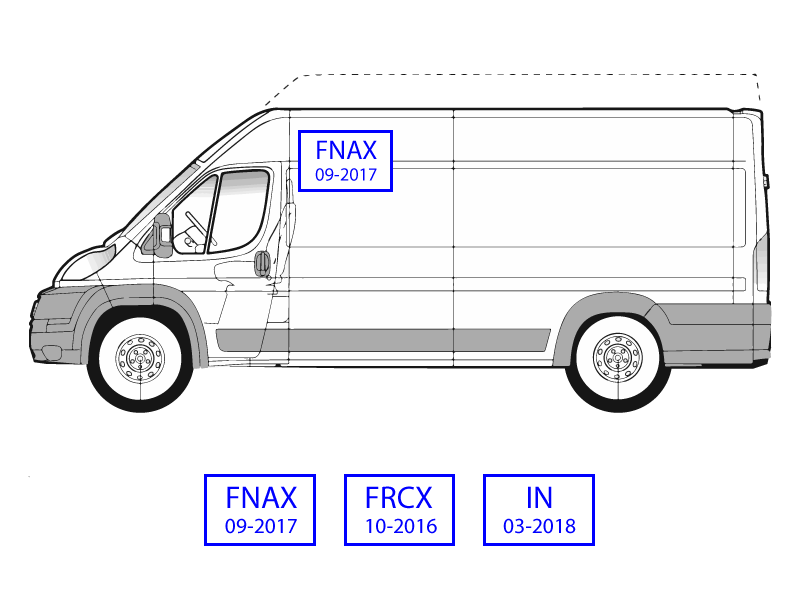The ATP regulation
Accord
Transport
Perissable

ATP is an international standard for the regulation of refrigerated, refrigerated, temperature-controlled transport of perishable foods intended for human consumption
The means of transport used for the transport of perishable foods must be approved and comply with ATP regulations and to be put into circulation they must have a certificate, the so-called ATP certificate. This certification has the same value as the registration document for a motor vehicle: without this document, the vehicle cannot circulate. The ATP certificate is issued to newly built means of transport with a validity of six years from the date of issue.
YEARS
After six years from the first issue, the ATP certification must be renewed!
It is possible to do this at an ATP testing laboratory authorized by the Ministry of Transport, such as AERFRIGOR.
YEARS
After the first renewal it is necessary to renew the certificate every three years! This is up to the twelfth year of the equipment's life.
Main ATP classes
Classification of vehicles used for the transport of foodstuffs according to the type and necessary transport temperatures.

They have a thermally insulated body and can keep the temperature in the cell constant and unchanged, avoiding the causes of dispersion. The vehicles in this category can be marked with two acronyms:
- IN: identifies vehicles with a thermally insulated compartment, but without a cooling unit.
- IR: Isothermal structure with a strengthened degree of insulation, but without cooling unit.
They have normal or reinforced isothermal bodywork. The refrigeration unit maintains the set temperature constant. The refrigeration unit maintains the set temperature constant. The indicated temperature is equal to 0 degrees in normal isothermal vehicles, reinforced ones can even reach the minimum temperature of -20 degrees.
- FNA and FNAX: isothermal structure with normal insulation level equipped with a refrigeration unit suitable for the transport of fresh food products at temperatures greater than and equal to 0 °C.
- FRA and FRAX: isothermal structure with a reinforced degree of insulation and equipped with a refrigeration unit suitable for the transport of fresh food products at temperatures greater than and equal to 0 °C.
- FRB and FRBX: isothermal structure with a reinforced degree of insulation and equipped with a refrigeration unit suitable for the transport of food products at temperatures greater than and equal to -10 °C.
- FRC and FRCX: isothermal structure with a reinforced insulation level and equipped with a refrigeration unit suitable for the transport of frozen and quick-frozen food products at temperatures of -20 °C.
They are equipped with eutectic plates or other equipment that keeps the temperature below -20 degrees. Eutectic plates are units capable of accumulating cold and then releasing it into the cell. These vehicles are intended for the transport of foods that require low temperatures.
- RRC: isothermal structure equipped with eutectic plates for the distribution and transport of food at temperatures below -20°C (typically used for the distribution of ice cream and frozen foods).
Transport substances and temperatures
Temperature conditions to be respected during the transport of food substances
| Food substances | Maximum temperature at loading and during transport | Temperature increase tolerable for short periods |
|---|---|---|
| Fruit ice creams and frozen fruit juices | -10 °C | +3 °C |
| Other ice creams | -15 °C | +3 °C |
| Frozen or quick-frozen fishery products | -18 °C | +3 °C |
| Other frozen food substances | -18 °C | +3 °C |
| Frozen butter or other fatty substances | -10 °C | +3 °C |
| Offal, shelled eggs, frozen poultry and game | -10 °C | +3 °C |
| Frozen meat | -10 °C | +3 °C |
| All other frozen food substances | -10 °C | +3 °C |
| Substances | Temperature during transport |
|---|---|
| Raw milk transported in tanks or drums from production companies to collection centers or directly to heat treatment and packaging plants for direct consumption | +8 °C |
| Raw milk transported in tanks from collection centers to heat treatment and packaging plants for direct consumption | from 0 °C to +4 °C |
| Pasteurized milk transported in tanks from one heat treatment plant to another heat treatment and packaging plant for direct consumption | from 0 °C to +4 °C |
| Pasteurized milk, in packs | from 0 °C to +4 °C |
| Dairy products (fermented milks, cream or milk cream, fresh cheeses, ricotta) | -from 0 °C to +4 °C |
| Butter and concentrated butter (anhydrous) | from +1 °C to +6 °C |
| Liquid anhydrous butter | > to +32 °C |
| Fresh fish products (always transport under ice) | from 0 °C to +4 °C |
| Meat | from -1 °C to +7 °C |
| Poultry and rabbits | from -1 °C to +4 °C |
| Game | from -1 °C to +3 °C |
| Offal | from -1 °C to +3 °C |
| Lamellibranch edible molluscs, packaged, including shelled ones belonging to the genus "Chlamys" (canestrelli) and "Pecten" (scallops) | +6 °C |
Operativity suggestions
Do you have vehicles under the ATP regime? Do you want to buy a used vehicle?
Check that everything is in order.
Correct position of the sticker on the side of the vehicle indicating the class to which it belongs and the expiry date.



